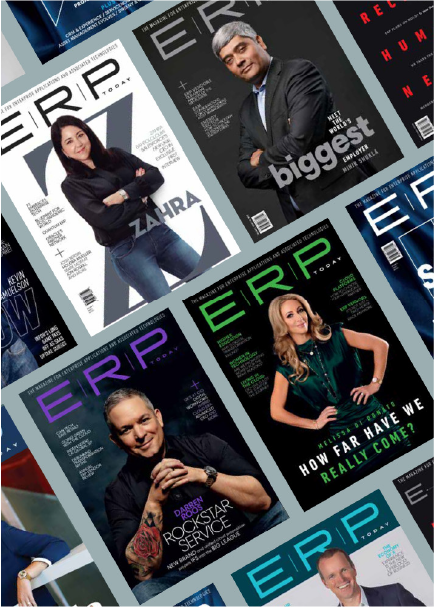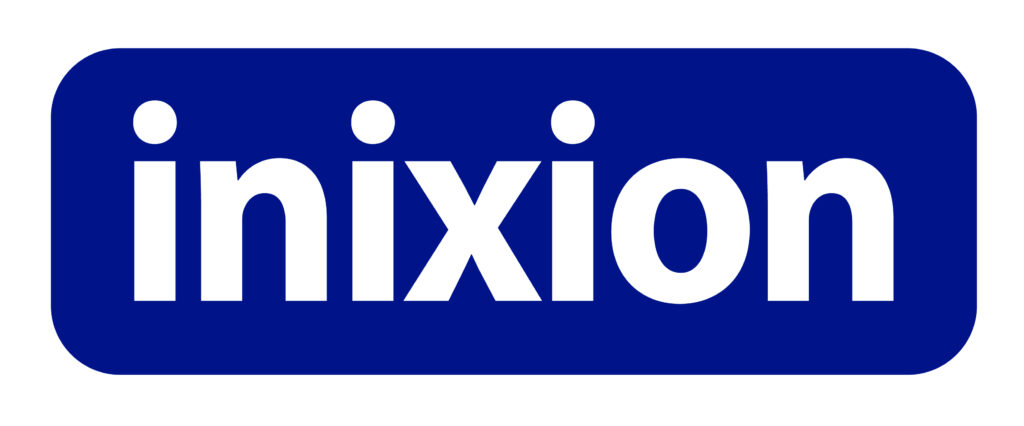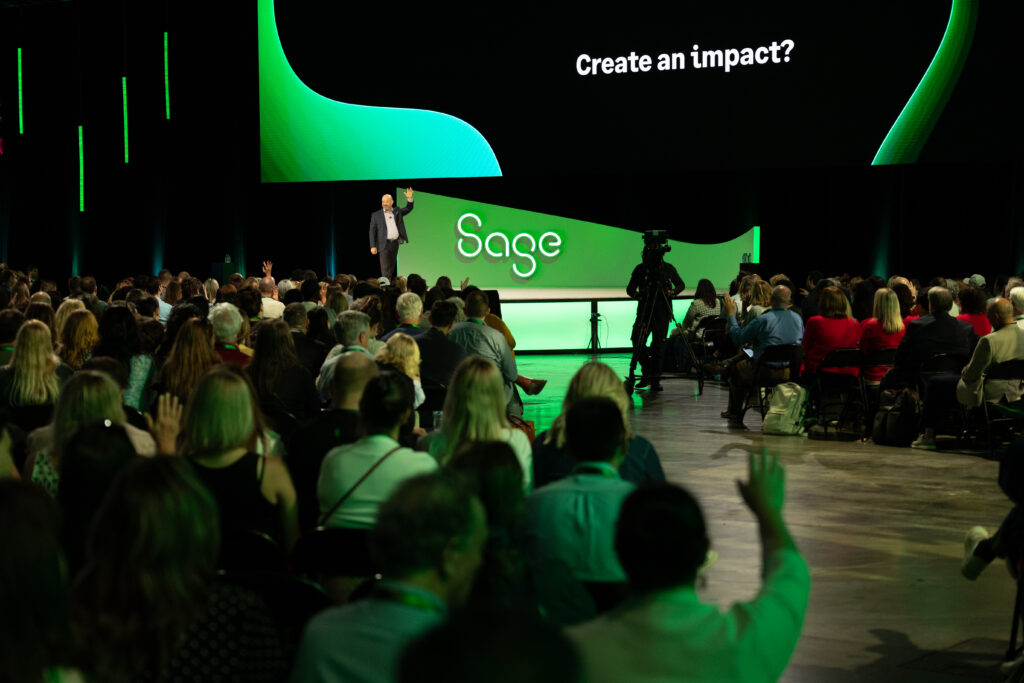The relentless march of artificial intelligence (AI) often conjures images of automated impersonality in the ERP industry. However, Sage is doubling down on a decidedly human-centric approach to AI.
ERP Today sat down with Sage’s Dan Miller, EVP of ERP and Finance, and Rob Sinfield, SVP of ERP, during the Sage Future Conference in Atlanta this week. They pulled back the curtain on an AI strategy that prioritizes practical value, user trust, and incremental innovation over the chaotic rush to be first. Their vision? To empower mid-market businesses with cutting-edge tools and the confidence and support to navigate an increasingly complex digital landscape.
For Sage, the current wave of innovation for its flagship products, Sage Intacct and Sage X3, focuses on targeted investment in a platform designed to solve tangible problems. “The platform enables us to bring capabilities like AV automation,” Miller said. The core idea, he elaborated, is to leverage technology that “knows who you are, knows what you have rights to, and knows what you’re trying to accomplish so that we can create informative workflows, embed them into those solutions, and design things around time-saving.” 
This focus addresses critical pain points. “We know that the finance industry is facing a labor shortage,” Miller noted, pointing to the dwindling number of new accountants compared to retirees. In operations, the continued pressure on margins and the need for efficiency, visibility, and predictability in the supply chain demand more innovative tools.
The Misunderstood Mid-Market
The ERP landscape is a whirlwind of change. Still, according to Sage, many in the industry might be misjudging the actual needs of mid-market businesses. Sinfield believes Sage is doing the right thing and doing it differently by focusing on delivering capabilities to people that drive value and how they can get a good return on their investment. “So, the big differentiator is building in AI that serves a purpose and helps people derive value from it,” Sinfield noted.
Miller echoed this sentiment, referencing the morning keynote on AI. “One of the things people are still not quite getting right is they’re feeling the pressure to adopt AI rapidly,” Miller observed. “But, we have to get it right, not be first. There’s a high risk of getting it wrong.”
Sage aims to serve customers effectively, helping them build strong relationships. Thus, Miller cautioned that rushing into AI without sufficient experimentation risks damaging those relationships. “I encourage companies to be prudent about adoption and find out who you can trust,” he said.
Illuminating the Supply Chain’s ‘First Mile’
A prime example of Sage’s practical innovation is the newly launched Sage Supply Chain Intelligence solution. Miller painted a stark before picture: “Before, if a company was not using a solution, they had very little visibility, relying on manual processes and running the risk of experiencing stock outs that could damage the business.”
Sinfield dived deeper into the after scenario. “If you think about it, companies, when they send a purchase order out of the building, it’s a little bit of a black hole,” he stated. He then explained three key features where Sage Supply Chain Intelligence changes the game for companies: “Firstly, the solution offers a collaborative workspace, providing procurement experts with a single view of vendor interactions and open orders, eliminating the need to sift through countless emails. Secondly, it delivers analytical information and insights into my trusted vendors and those who are constantly late. And thirdly, it provides real-time insights into where the goods that I’ve ordered are as we’ve added capabilities that allow us to see where a container is in real-time.” 
Sinfield explained that the professed “aha!” moment for users comes from this newfound visibility. “Most of our customers go, ‘Ooh, I didn’t realize. I didn’t see what was going on there, or I didn’t realize that I had that much money sitting on the water at the moment.,” he said. This translates into tangible benefits like freeing up capital, improving inventory turns, reducing risk, and fostering better supplier relationships.
Augmenting Humans, Not Replacing Them
With AI embedded into core processes, Sage’s approach to its Intacct roadmap remains grounded in solving specific customer pain points. “Our belief is that AI is a tool to be used by people to augment their capabilities so they’re spending more time on a company’s strategic tasks than manual work,” Miller asserted. Whether it’s reducing time spent on AP, streamlining the financial close, or getting faster answers about financials, the development is customer-driven.
This philosophy extends to Sage Copilot, which Sinfield emphasized is far more than a clever Q&A bot. He offered a compelling scenario for a production planner: “Say, raw materials are late, and the weekly schedule needs urgent replanning. By taking advantage of AI and looking at how the copilot can provide a recommendation. Do you want to focus on revenue impact? Or do I want to prioritize my biggest customers? Sage Copilot facilitates this analysis and collaboration, allowing for swift, informed decisions without a complex manual replanning exercise.”
He added, “We’ve used Sage Copilot to do the analysis, facilitate collaboration, flag an issue before it’s become an issue, drive an outcome, and also trigger an energetic workflow.” This management by exception capability is powerful. AI can flag invisible production anomalies, such as a slight degradation in production time per item or a series of quality control failures.
Miller added the finance perspective: “We know that it’s hard for customers to get a clear view of what short-term cash will look like. So, we’ve introduced predictive capabilities that alongside them with AI to help augment that view based on their data.”
Building Trust in an AI-Powered World
The crucial question, especially for traditionally less tech-forward SMEs, is how to foster trust in these AI-driven insights. Miller highlighted Sage’s commitment: “We have built into our solutions a trust label so that users can see how we make the recommendations. We follow a set of principles and strictly follow our core value, ‘Being Human,’” Miller said.
In many mid-market businesses, professionals wear multiple hats. Technology, Miller argued, helps them manage these demands and shifts their focus from reactive data entry to proactive, strategic contributions. “We’re seeing an expectation that they [finance and operations leaders] are now in roles where they are helping businesses make decisions about how the business is going to progress. We’re trying to enable them to be proactive in this area with our solutions,” he said.
Leveling the Playing Field for the Mid-Market
This proactive stance is key to how Sage helps mid-market businesses compete against larger enterprises. “We know that the mid-market is in this interesting place where they often have budgets that look like smaller businesses but have needs that look like the enterprise,” Miller stated.
Sinfield shared an anecdote to drive home this point: “I recently spoke with a $25 million manufacturer who chose Sage. The company told us this was because we’re a very human company; there’s a value exchange, and they don’t feel like they’re buying stuff they don’t need. The fact that it’s purpose-built for an SME with workflows that reflect how they would like their business to work made the decision easy for them.”
He emphasized that Sage flips the traditional 80/20 rule by giving clients 80% value, compared to traditional approaches, where value makes up only 20% of the total package.
The feedback from early adopters of Supply Chain Intelligence and the X3 Copilot program reflects this value.
“The feedback from all [early adopters] is, I’m just able to be more effective,” Sinfield reported. Sinfield noted that the consensus is incredibly excited for X3 Copilot, where 44 customers are in the early adopter program. “They can see real value in the use cases that we’ve built out.” Miller stressed the importance of this phased approach, adding that Sage wants the solution to be right more than being hype.
The Next Frontier: Democratizing ERP
Looking ahead, both executives are focused on dismantling a long-standing ERP challenge – Dismantling the monolithic ERP.
“ERPs are generally monolithic, quite difficult, and it’s like putting a business through different surgeries simultaneously,” Miller stated. “The approach we’re taking to build best-of-breed capabilities is that ERP can be implemented by a customer incrementally and break up the monolith. This is something that I’m very excited about.” The goal, he said, is to “fundamentally change how people consume new applications. Why can’t there be a value exchange after each increment of that process?”
Sinfield concurred: “What we see happen for customers is they feel stuck because they have to go through so much change all at the same time.” Sage’s strategy involves purpose-built solutions like Sage Distribution Manufacturing Operation (SDMO) for operations and Intacct for finance, designed to work closely together but are adaptable in pieces.
What This Means for ERP Insiders
Prioritize getting it right over being first with new tech. In a field often swept up by the next big thing, Miller’s emphasis on being prudent about adoption and ensuring solutions are right before wide rollout is a crucial lesson. The risk of damaging customer/user relationships or business processes with ill-conceived or rushed technology implementations is high. Advocate for thorough vetting, pilot programs (like Sage’s early adopter approach), and a clear line of sight to ROI before committing to widespread deployment of emerging ERP technologies, especially AI.
The monolith is crumbling. Both executives highlighted the pain of traditional, monolithic ERP overhauls. A significant trend is the shift towards more composable, incrementally adoptable solutions that deliver value in stages. This means providing best-of-breed capabilities that integrate well is becoming critical. ERP professionals should strategize how to break down large-scale transformations into manageable, value-driven phases and champion solutions that offer flexibility and integrate smoothly.
Target tangible ROI by directly addressing pressing business bottlenecks. Innovation must be laser-focused on solving acute business challenges like labor shortages, margin pressures, and time-consuming manual processes, especially with AI. Instead of technology for technology’s sake, the imperative is to deliver measurable returns quickly. ERP professionals should champion initiatives that demonstrably alleviate specific operational or financial pressures, ensuring that every new feature or module directly contributes to quantifiable business outcomes and provides a clear return on investment.



